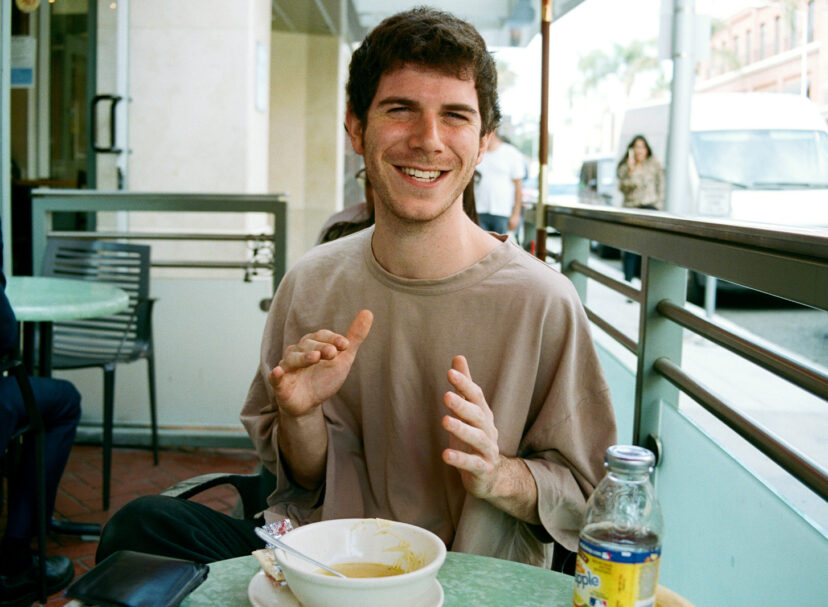Text: Alec Coiro
Photo: Kat Slootsky
Kodomo is the music handle of Chris Child. I meet Child for coffee near his studio in Williamsburg. He is a personable music professional who makes a living creating music for video games, television, and these days primarily commercials. But it’s these professional endeavors that make his solo work all that much more his passion. “It’s really important to me that I work on my own music. I think it’s the hardest at the end of the day, and the least financially rewarding, but it’s very important.” What this passion gives rise to is music that can broadly be described as electronic. If you had to get more specific, you could maybe say ambient, but it’s certainly not part of any known techno or electro or house genre. According to Child, it’s a “hyrbid type of approach, not a techno record not a specific kind of house.” Although, as Kodomo, he has lived through all the big eras in electronic music, and we touch on his big influences like the Orb and Orbital (all the major spherical 90s outfits, really).
He’s the type of guy who went to all the key raves, but was never the raver doing the big pants rave dance. “I wasn’t really a club kid. I’d go to a lot of the clubs and raves but I was always the observer; I was never the crazy dancer. I was very boring, but I loved the music. There’s always the discrepancy between the cheesy stuff and the stuff that was coming out of England and Germany at the time that was appealing to me. That was a really revelatory time for electronic music culture. It was being performed for the first time actively.” In this canon of revelatory electronic music he includes the aforementioned Orb and Orbital along with Underworld and Autechre. Clearly, he’s someone who takes electronic music seriously, and comes at it from multiple angles: both the techno perspective as well as the experimental music perspective. The new album, for example, is heavily inspired by the Estonian composer Arvo Pärt. “He’s major 20th-century heavyweight. I grew up studying a lot of classical music, and the past few years I’ve been listening to a lot of his music. I really love it, and I started studying piano reductions of some of his music and loosely borrowed some of his techniques. It’s an interesting take on melody, harmony, and structure. More of a way that was done in medieval times, going back to Gregorian chants.”
But getting to heart of Kodomo, it’s helpful to go deep than his influences and further back than ‘90s electro to his years growing up in Japan as the son of a diplomat. He’s been a citizen of the world since childhood, which could explain his resistance to being tied down to any one sub-genre. Kodomo means “child” in Japanese, and “the Running joke in Japan is that Child-san is an honorific for an adult. It sounds oxymoronic.” So Kodomo as a nickname predates Kodomo as a stage name for Child. He was back in the States for college. He did the full four years at Berklee College of Music in Boston, and from there he went to work for Harmonics, the company that developed Guitar Hero and made Rock Band as well as every other Music-based video game developed in the U.S. I think this nuts, like meeting someone who dated Zelda, but for him it was just another job. “It’s pretty structured. It’s a tech company.”



What’s pretty incredible about today's world of electronic instruments is we’ve gone full circle back to the early modular days, but now it’s working perfectly with the modern equipment that’s come out. I can use this with all the contemporary gear but I can use it in new ways.

After Harmonics he made his way to New York, and ultimately the studio that he’s in now. He offers to give me a tour and I take him right up on it. For the synth fan, he’s got everything you could want stacked up to his right; plus he’s got all his collectors overflow of smaller synths stacked behind him. His top two synths appear to be the ARP 2600 and the Moog Voyager. I’m enthralled as gearhead, but maybe even more so as Tetris fan/organization enthusiast. He’s taken the inevitable mess out of the studio and imposed some Japanese order on the space. Indeed, I’m standing there with my shoes off as he explains that “What’s pretty incredible about today’s world of electronic instruments is we’ve gone full circle back to the early modular days, but now it’s working perfectly with the modern equipment that’s come out. I can use this with all the contemporary gear but I can use it in new ways. You can send rhythmic information from the computer to the synth to manipulate the filter. Or I can sequence it using various sequencers that are also controlled by the computer. So you have a detailed level of control over it.” Then he gets at why it’s important to put the effort into analog over emulation. “You still have to tune it because it goes out of tune every 5-6 minutes. But that’s what makes it charming because it’s not a perfect machine, it’s more like a real instrument. If it repeating something, it’s a little different every time.”
The new album, Divider, that all of this gear helped concoct will be release on August 18th. For his latest album, he’s tried to focus on unity: “This one is more of a cohesive collection. And that was definitely the intention. A lot of the song have some of the same sounds. The idea was to have a very specific palette to work with.” Part of that palette includes found materials.
“A lot of the sounds I use, I’ll record around. I carry a field recorder or even my iPhone voice recorder. A lot of construction and stuff like that, which wound up being useful for big epic sounding hits.” In terms of the musical style on the new album he says, “It hits on a fusion of stuff that I wanted to do, which was combine noisy ambient inspired music with more techno-inspired music, and also have this compositional thread running through it.”
With the album finished, he’s working on the live version now. I ask him what the process of playing live is like. He explains, “I reconfigure everything I add in new synths drum machine some controllers and software that I use to make an improvisational remix of the songs. It’s different from what’s on the record. There are some lead lines that I play, but the majority of the live part is really triggering sounds, shaping patterns, sample manipulation, and controlling what parts get played when.”
Catch the live version if you can, and definitely give the Divider a listen on August 18th.

